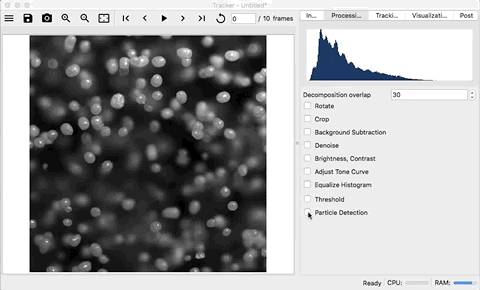Process Images¶
After the media is opened, the individual frames are processed using a series
of transforms. These transforms are applied and controlled on the Process
tab. Unfortunately, which transforms to use depend heavily on the media. The
basic goal is to maximize the contrast between the objects and the background.
This process is very subjective, requiring trial and error.
Filters and transforms are applied sequentially in the order they are listed in. The results of individual steps can be seen by hovering over the filter or transform options.
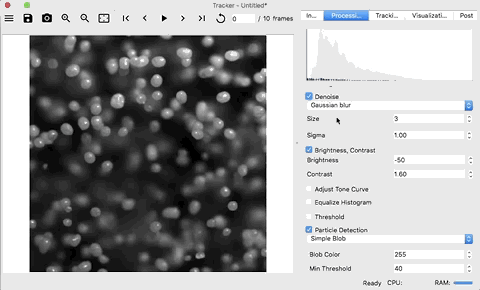
Histogram¶
The first widget on the processing tab shows the histograms of the pre-processed frame (light gray) and the final processed image (dark blue) of the currently displayed frame. The histogram shows the normalized counts of pixels at a certain value. A counts of pixel values of 0 (black) are on the left side and counts of pixel values of 255 (white) are on the right side.
Decomposition Overlap¶
When using parallel processing, there needs to be an overlap between neighboring tiles just larger then the largest object being tracked. Having an overlap too small will cause tracks to be lost while having an overlap to large will cause extra processing of pixels.
Note
To see the tiles, go the the visualization tab and select the
Show domain decomposition check-box.
Rotating¶
Frames can be rotated in increments of 90° by checking the Rotate check-box
and selecting the amount of rotation to apply.

Cropping¶
Frames can be cropped by checking the Crop check-box and entering the amount
of pixels to crop. The Left and Top entries are positive integers while
the Right and Bottom entries are negative integers.
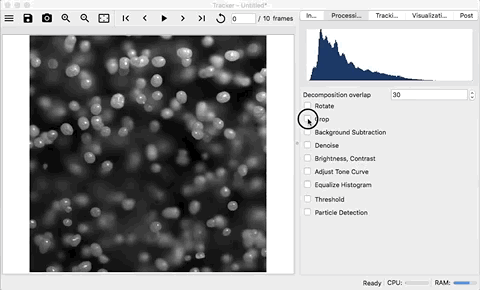
Background Subtraction¶
If there are structures in the image that do not move, these can be removed by
using background subtraction. Background subtraction can be enabled by selecting
the Background Subtraction check-box. There are three methods available:
1. mean - builds and updates an array of frames which is used to calculate a
moving mean for each pixel. This mean is then subtracted from every frame. This
method is implemented using numpy.
2. MOG2 - “Improved adaptive Gaussian mixture model for background
subtraction” as implemented in
OpenCV
3. KNN - “K-nearest neighbors - based Background/Foreground Segmentation” as
implemented in
OpenCV
See How to Use Background Subtraction Methods for more information.
Note
The history of the background subtraction methods is constructed as the frames are processed, so the first frame will typically be blank since there is no history.

Denoise¶
Noise can be removed from frames by selecting the Denoise check-box. There
are three methods available:
- Gaussian blur
- Median blur
- Bilateral filter
These three methods are implemented in OpenCV. See Smoothing Images for a tutorial with all three methods and more information.
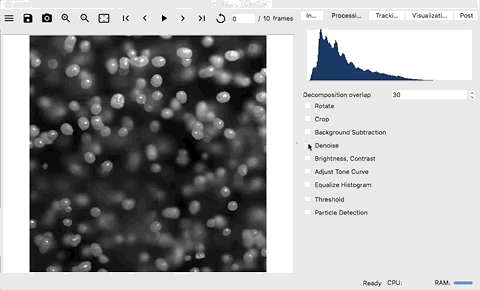
Brightness and Contrast¶
The brightness and contrast of the frames can be adjusted using a linear
transformation of the pixel values by selecting the Brightness, Contrast
check-box:
Where \(\alpha > 0\) and \(\beta\) are said to control contrast and brightness respectively. \(f(i,j)\) is the pixel value of the input and \(g(i,j)\) is the pixel value of the output.
See Changing the contrast and brightness of an image for more information.
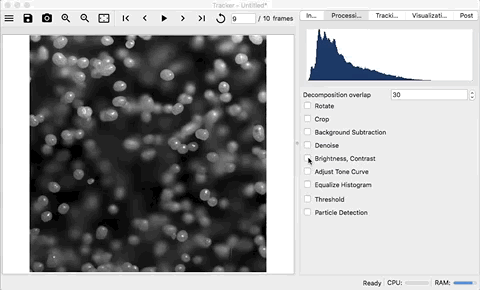
Tone Curve¶
The brightness and contrast of the frames can be also be adjusted using a user
controlled spline that is fit through 4 points, similar to tools found in
Adobe’s Lightroom, by selecting the Adjust Tone curve check-box. This is
similar to the linear transformation except that the input pixel values,
\(f(i,j)\), are transformed with a B-spline, \(h()\), resulting in the
pixel value of the output, \(g(i,j)\):
Scipy’s splrep is used. This allows significant user control over increasing the contrast of the objects of interest.
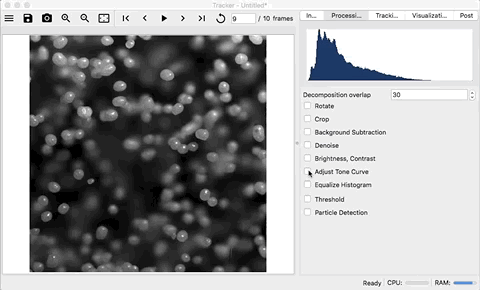
Equalize Histogram¶
The contrast of the frames can be also be adjusted by using histogram
equalization by selecting the Equalize Histogram check-box. Histogram
equalization tries to stretch the intensity of the pixels to use the full range
of available values (0-255). In some cases where the lighting is not uniform,
adaptive histogram equalization can be used by selecting the Adaptive
check-box. This will use the Contrast Limited Adaptive Histogram Equalization
(CLAHE) technique as implemented in OpenCV. See
Histograms - 2: Histogram Equalization
for more information.
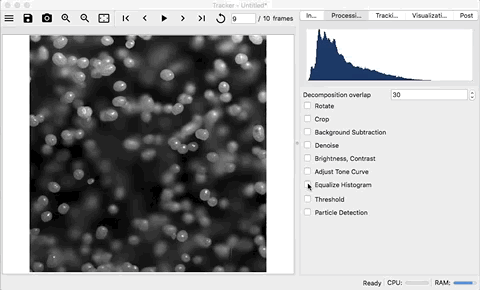
Threshold¶
A threshold can be applied to the frame by selecting the Threshold
check-box. There are several types of thresholds that can be applied:
| type | condition |
|---|---|
| binary | \(g(i,j)= 255 \text{ if } f(i,j)>thresh \text{ else } 0\) |
| binary inverted | \(g(i,j)= 0 \text{ if } f(i,j)>thresh \text{ else } 255\) |
| truncated | \(g(i,j)= thresh \text{ if } f(i,j)>thresh \text{ else } f(i,j)\) |
| to zero | \(g(i,j)= f(i,j) \text{ if } f(i,j)>thresh \text{ else } 0\) |
| to zero inverted | \(g(i,j)= 0 \text{ if } f(i,j)>thresh \text{ else } f(i,j)\) |
Where \(f(i,j)\) is the input pixel value, \(thresh\) is the selected threshold value, and \(g(i,j)\) is the resulting output pixel value.
For more information see Image Thresholding

Particle Detection¶
The last step in the processing of the images is the identification of the
objects. To apply a object detection filter, select the Particle Detection
check-box. There are three object detection filters including Simple Blob,
Label, and Hough Circles.
Simple Blob¶
Simple blob
is an efficient algorithm for finding blobs in an image. It works by finding
centers of contours at several thresholds from Min Threshold to
Max Threshold, groups the centers, and then filters the blobs based on
area, circularity, inertia, and/or convexity. This method is the preferred
method for identifying objects.
Label¶
If either a binary or binary inverted threshold is used, then the
groups of pixels can be
labeled
. The centers of the labels can then be determined and used. This technique does
not work well when objects are touching.
Hough Circles¶
The Hough Circle Transform tries to find circles in an image. This transform works well if the objects are nice, fairly uniform circles, however it is sensitive to the input parameters and can be expensive. It can find overlapping circles.
